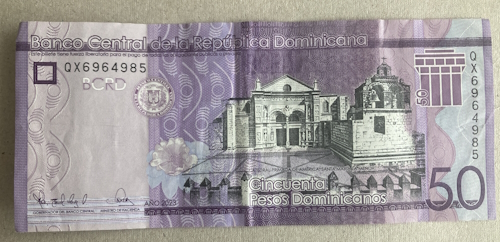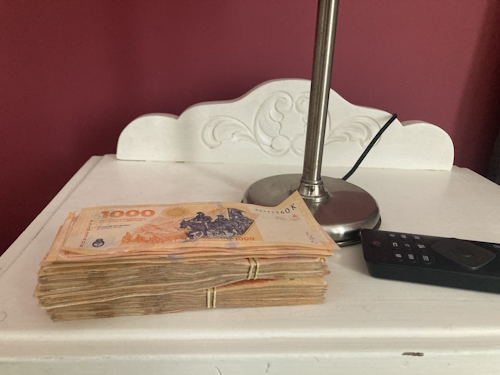Blog Travel in general
Trip Budgeting
Since I ‘retired’ I have become more focused on budgeting my trips correctly, as the main difference between working a monthly waged job and living off a lumpsum is that your money doesn't get replenished as easily. I can only spend it once. On a macro level, I have implemented a few financial rules such as a yearly travel budget and an average budget per WHS (650 EUR). But also for each trip I manage my finances carefully without pushing myself into a frugal mode.
I just came back from a 5.5-week trip that took me to the US, Jamaica, Dominican Republic, Uruguay, Argentina and Chile. This was complex enough to provide feedback on my trip budgeting routine due to the different currencies, variable costs of living and the Argentine inflation situation.

Setting the Trip Budget
This trip would – if all went well – bring me to 13 new WHS. So at 13x 650 EUR, a maximum budget of 8,450 EUR was appropriate. Corrected with the real costs in these countries and the costs of international flights, I set a range of 7,800 – 8,200 EUR. In the end I spent 8,173 EUR.
Detailing the Trip Budget
For each trip, I use the same spreadsheet to create a detailed trip budget. It has the following categories:
- Hotels: I always book my hotels about a month beforehand, but in such a way that the dates are changeable. So the hotel budget is already quite clear before I leave.
- Food: I know from experience that in most countries I can do 20 EUR a day if the hotel provides breakfast. Very cheap countries may require only 15 EUR, more expensive ones 25 EUR. As this trip was mostly in Argentina and Chile, I chose the ‘average’ option of 20 EUR a day.
- Transportation: I covered 28,442 km overall on this trip, so I knew it would be costly. It’s a combination of international flights (in this case, Amsterdam-Miami, San Juan-Montevideo and Santiago-Amsterdam) and domestic flights, bus tickets and car hire expenses.
- Tours and entrance fees: I look up all entrance fees beforehand of the sites I plan to visit, plus allocate 100-150 EUR for a private day tour and 50 EUR for a shared one (if I don’t know the exact costs already).
- Other: this is a tricky category, as it always seems low but it can add up. The main expenses here are SIM cards and credit card fees.
Tracking the Trip Budget
I do note down every day what I spend, and allocate these costs to one of the categories mentioned above in the spreadsheet. It looks like this:

Lessons Learned
Although I stayed within the overall budget for this trip, I’ve done better.
- For Hotels, I managed to stay 300 EUR below my budget. Often in Argentina and Chile, I paid less than was indicated when I booked initially – thanks to the devaluation of both pesos. I also got a 10% discount in Buenos Aires if I paid in cash USD. Furthermore, I often rechecked whether the same hotel offered cheaper rates closer to the arrival date. This way I managed to shave off a bit too, in Argentina and Chile. Overall, I spent ca. 52 EUR a day on hotels which is quite good I think considering the expensive countries that were also in this itinerary.
- For Food, I almost matched my budget but it was hard. Fortunately, except for Argentina, these aren’t countries known for their great cuisine so I did not miss out on much when I took a ‘budget food day’ (usually at McDonalds or an empanada place).
- Transportation was the real killer on this trip, I spent 600 EUR more than I had planned and this category covered 58% of all trip costs. I knew the big numbers of the flights beforehand but hadn’t counted for the taxi costs which added up in the Caribbean (where public transport to an airport seems non-existent) and that I needed to switch to car rental instead of buses to cover Northern Argentinian Patagonia. Also, the price of fuel for a rental car is high in Chile.
- For Other, I needed 3 different SIM plans (US, Jamaica, South America), and even switched to a fourth for Chile only. The Airalo e-SIMs provided the best value for money.

A general money headache for this trip was getting hold of US dollars. They are very expensive to buy in NL (effectively over 1 EUR per 1 USD). What I did in the end was bring some dollars that I had left from earlier trips and get more from ATMs in Miami and Puerto Rico. There I paid about 0.95 EUR to the dollar. If I were to do it again, I would bring less USD (only needed to pay 2 hotels) and more EUR to change into the local currencies (notably the Argentine peso, Photo 3 shows 200 EUR worth of pesos in Feb 2024).
On the positive side (and not reflected in the trip total), I ‘earned’ 800 EUR in KLM vouchers when my initial flight to Miami was cancelled and replaced by one that arrived 5 hours later. I already used it to buy tickets for a trip to India later this year.
Do you have special Travel Budgeting ‘hacks’?
Els - 31 March 2024
Comments
Patrik 17 April 2024
I am in a similar situation as you, as I quit my job 7 years ago to travel, using my savings. Initially I did part of my travels with my car until it broke down near Naples and I sold it. It was unpractical anyway as it had to be taken off the road when I travelled outside Europe for longer time to avoid paying road tax and insurance.
My starting point is that 'time' is an almost unlimited resource, where 'money' is limited. I have set a daily budget of €50, and I also use a standard spreadsheet, though it is yearly with separate tabs for each trip. I log every expense in the sheet but do not have specific categories, except for accomodation. The sheet then also becomes a kind of log, showing which museums I visited and which daytrips I made.
During the trip, I measure if I am 'above' or 'below' budget, without worrying too much about it, the point is just to be aware. I have been consistently below budget these years though it seems I will need an inflation correction this year.
I travel with a focus on WHS, but visiting WHS is not my main purpose. So I do not have a budget per WHS and also skip (natural) sites that I consider too expensive. I have skipped Serengeti for example when I was in Tanzania and have not felt any regrets (something I was worried about when deciding). I instead went to a nature reserve that was on the t-list and had a wonderful experience.
I often make longer trips (4 - 8 months) and fly very little during them. Also, I barely use taxis and shuttles as I dislike them, and generally do not take tours as I find them limiting instead of adding to the experience. To get to places I take public transport and also find hitchhiking enjoyable and fun, to my surprise. And sometimes I walk somewhere with my backpack for a day or so, very relaxing and enjoyable.
My daily accomodation budget is around €20 and depending on the country, this will often mean I stay in airbnb's, and very occasionally in dorms. I like apartments or shared apartments where I can use a kitchen to cook veggies and have nice bread for breakfast, something I miss when eating out for longer periods of time. I thought I will do camping as well but have never gotten to it.
I stopped buying local sim cards (my phone is not able to use e-sim) as the prepaid packages seem to focus lately on selling huge amounts of data for limited periods of time, and it adds up when one just needs 0.5 GB for a month. So I just use wifi when available.
I try to pay directly as often as I can with my NFC chip on my phone, which has a free virtual debitcard which does not add bank fees to the conversion rate, so this is the cheapest way to pay when available, it saves about 1.4% compared to other debit cards or atm cash . It's not a lot, but it adds up.
The other thing is that I often look for cheap flights or train/bus tickets, and based on this see if I can build an interesting itinerary out of it. For example last year my 4 months summer trip started with buying a €22 DB train ticket to Austria 6 months ahead and from there I started booking next steps, towards the Balkans. I often book up to 3 months ahead and then do the rest while traveling. During the trip it will somehow become clear when it has been long enough, and then I will start to see how to get back, usually by booking a cheap plane ticket from somewhere which will then be my destination. It's like a game.
By the way, in my spreadsheet the currency is € for every post. As one of my purposes is to track expenses, I need one currency to be able to compare on a daily basis. I use a conversion cell, so if I spent 10.000 COP in cash, I write for example 10000*q1, which then calculates the amount in € and shows €2.50. And when I pay by card, I write down the actual amount in €. I noticed you seem to do this differently.
Chris W. 31 March 2024
One thing I do heavily is the points&miles game. Now I must say, espcially the miles part, was easier as pre-covid. This way often one can travel around cheaper. But, I do see these as additional trips and not budgetted for the current trip. I would however, if it makes sense, hop hotels on a three night stay (that is 3 hotels instead of just one). Or fly with stopovers just to get more miles.
I do not really use public transport (except for example high speed trains in China). It’s often slower and the faster way make sense so I can work in the morning or evening. Not retired yet.
Els Slots 31 March 2024
Fortunately that wasn't needed on this trip, Michael! But indeed, usually, I put things like visas or vaccinations also in the Other category.
Michael Ayers 31 March 2024
Don't forget to include a line item in the "other" category for "repetitive testing for newly emergent viruses by pcr/antigen." Last time, that added up to $US 2,800 for me... ;-}